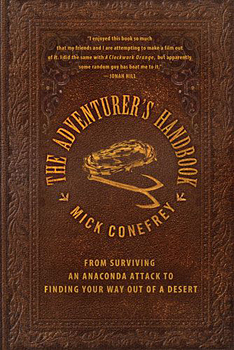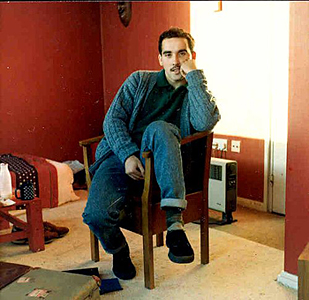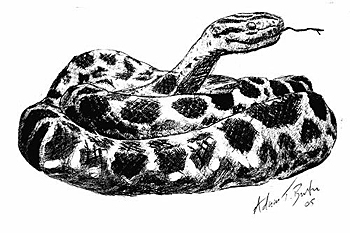The Adventurer’s Handbook: A Practical Guide for Intrepid Travelers
Excerpted by Beth Simmons
 A mix of adventure, history, and plenty of practical advice, “The Adventurer’s Handbook: From Surviving an Anaconda Attack to Finding Your Way Out of a Desert” by Mick Conefrey has a bit of everything for everyone. A literary global adventure from start to finish, this book has the potential to be your next go-to travel read. For those still doubtful, feast your eyes on the black and white sketches by Adam T. Burton, making this a beautiful book inside and out.
A mix of adventure, history, and plenty of practical advice, “The Adventurer’s Handbook: From Surviving an Anaconda Attack to Finding Your Way Out of a Desert” by Mick Conefrey has a bit of everything for everyone. A literary global adventure from start to finish, this book has the potential to be your next go-to travel read. For those still doubtful, feast your eyes on the black and white sketches by Adam T. Burton, making this a beautiful book inside and out.
Conefrey’s artistic chops have reached beyond writing and into film as well. As an acclaimed film director and producer, Conefrey’s work includes documentaries, “The Race for Everest,” and “Mountain Men.” Now reaching beyond a documentary and adventure enthusiast audience, Conefrey’s “The Adventurer’s Handbook” is inspiring the making of a Hollywood movie starring well-known comedic actors, Jonah Hill, Jason Segel, and Jason Schwartzman.
If you haven’t heard of these guys you can find them on the cover of recent comedy flicks such as “Knocked Up, Superbad,” and “Forgetting Sarah Marshall.” In the film, the trio will follow in the footsteps of their favorite explorers within the Handbook on their own adventure expedition. Conefrey’s book cover even includes a quote by Jonah Hill saying, “I enjoyed this book so much that my friends and I are attempting to make a film out of it. I did the same with “A Clockwork Orange,” but apparently some random guy has beat me to it.”

In “The Adventurer’s Handbook,” Conefrey leaves his readers intrigued and inspired by partnering his advice with real historic explorers of the nineteenth and early twentieth centuries, including Scottish born explorer of Australia, John McDoullan Stuart.
Stuart became the first man to lead a group across the continent and return to speak about it. Dealing with the never-ending search for water in an uncomfortably dry and hot environment, Conefrey proclaims there are lessons to be learned from this nineteenth century explorer. Find out more about these lessons below in an excerpt from “The Adventurer’s Handbook:”
Hot
Francis Galton advised in his Victorian handbook The Art of Travel that sucking a lump of quartz or a bullet can allay thirst. He added that travelers had been known to add a little gunpowder to their food to satisfy their craving for salt. Neither of these measures would be recommended today, but there’s no doubt that for any explorer, extremely hot weather presents a serious problem.
Roughly 12 percent of the world’s surface is classified as dry, arid desert; most of this is found between 18° and 28° latitude in both hemispheres. For any traveler, there are two fundamental challenges: how to protect yourself from the heat and how to find an adequate supply of water. In the desert, temperatures can reach 135°F (57°C) during the day and fall as low as 16°F (-9°C) at night. Deserts are very challenging.
In normal working conditions, an average male needs approximately 3,000 calories of food per day, but can survive on as little as 500 for several months. When it comes to water, the body is much less flexible. In temperate regions, it is possible to live on two cups of water a day, but in a desert between one and three gallons (4.5-13.5 liters) are required. When the temperature increases, the need for water becomes even greater. At an air temperature of 50°F (10°C), it is possible to survive for 14 days without water; at 120°F, that drops to between 3 and 4 days, even for someone carrying a gallon of water.

Sweating is the body’s main response to excessive internal and external heat. When sweat evaporates off the skin, it cools everything below it. It is a fairly efficient process, but it is also a greedy one. On a hot day, it is possible to sweat two pints of liquid in an hour.
This must be replenished quickly; otherwise, your blood will start to thicken making it harder for the heart to pump it around the body. Anyone who loses more than 5 percent of his or her water volume will begin to deteriorate physically and mentally.
When this rises to 10 percent, he or she will go rapidly downhill, becoming deaf, delirious, and oblivious to pain. When water loss exceeds 12 percent, death frequently ensues.
A further problem with excessive sweating is that it drains the body of electrolytic salts, which are necessary for muscles to work properly. If these are not replaced, salt deprivation causes cramps and, in the worst cases, death.
It is possible to acclimatize, to an extent, to hot environments; within two weeks, the average person’s capacity to sweat can triple without any serious effects.
The fundamental principle of desert travel is to avoid any unnecessary loss of moisture. In the accounts of Europeans who set out to explore the deserts of North Africa, you often find references to the frustration of traveling with local guides who are invariably accused of being too slow or malingering. Usually these complaints occur at the outset.
Then, as the journey continues, the outsiders come to realize the good sense of traveling at a languid pace and making sure that when the opportunities present themselves, men and camels are allowed to drink their fill. The desert is a harsh teacher, and the Bedouin and other tribes have learned the lessons of how to survive over many thousands of years.
Tips for Desert Travel
1. Travel slowly and avoid any unnecessary exertion. It will only make you sweat more.
2. When traveling through a desert, it is best to move during the coolest period of the day: dawn and dusk or at night.
3. Dampening your clothes will keep you cool, but it is important to wipe off any salt that condenses on them. Salt is highly corrosive and can damage boots and clothing.
4. It does not usually pay to dig for water unless you are sure that you will find plentiful supplies; usually the effort required outweighs the benefits.
5. To minimize water loss, keep your mouth closed and breath through your nose. Avoid talking and any difficult work that will cause you to breathe through your mouth.
6. In summer, the ground temperature can be up to 30 percent higher than the surrounding air, so it’s better to rest on a stool or branch than to sit on the ground.
7. It is better to wear more clothing then less –fabric absorbs sweat and prolongs its cooling action.
The Travels and Travails of John McDouall Stuart

One of the greatest explorers of Australia was a Scottish immigrant, John McDouall Stuart. Between 1858 and 1862, he led six grueling expeditions to the unknown interior; on the final journey, he became the first man to lead a party all the way across the continent and return to tell the tale.
Stuart was an unlikely explorer. Small in size and prone to ill health, his fondness for whisky bordered on alcoholism. Stuart learned his bushcraft surveying the land north of Adelaide; he was very good at it and was often employed by local farmers to search for new grazing.
Stuart’s philosophy was to keep his expeditions small and mobile. He would scout ahead while the remainder of his team would make a depot at the last good waterhole. Then, when he had found the next viable source of water, he would bring the other men up.
On his first major expedition in 1858 Stuart took an Aboriginal tracker, but the man deserted halfway through; after that Stuart preferred to trust his own instincts. Water was a constant preoccupation; occasionally he found himself trapped by flash floods or held back by muddy ground, but most of the time he was desperately searching for water.
It was often a dangerous business: At one point, on of his assistants was almost buried alive when a well that he was digging in a riverbed collapsed on top of him. The Aboriginal tribes that Stuart met on his expeditions were frequently hostile. As if to add to his problems with the heat, they often set fire to the vegetation around his camps.

Stuart set off on his last major journey with a real feeling of pressure; after Burke and Willis’s disastrous transcontinental expedition, the public has become very skeptical about explorers and were much more reluctant to part with their cash.
A few days out he discovered that the water bags he had taken with him were so leaky that hey lost half their volume every day. Eventually he just abandoned them. When, finally, on July 24, 1862, he and his party reached Van Diemen Gulf, water dominated everyone’s thoughts.
As Stuart recorded in his diary: “Thring who rode in advance of me called out “The Sea!” which took them all by surprise and they were so astonished that he had to repeat the call before they fully understood what was meant. Then immediately they gave three long and hearty cheers… I dipped my feet and washed my face and hands in the sea, as I promised the late governor Sir Richard McDonnell I would do if I reached it.”
From The Adventurer’s Handbook by Mick Conefrey. Copyright © 2010 by the author and reprinted by permission of Palgrave Macmillan, a division of Macmillan Publishers Ltd.
Further Information:
Read more about Mick Conefrey and his work here.

Beth Simmons is an editorial assistant with GoNOMAD and attends the University of Massachusetts in Amherst, Massachusetts. She writes the Travel Reader Blog.
- The Wild Mississippi: 2340 Miles Across Ten States - April 8, 2024
- Exploring the Floating Villages of Tonle’ Sap Lake - April 3, 2024
- Woman Traveling Solo on Turkish Buses - March 27, 2024

